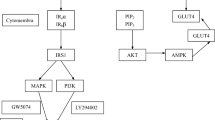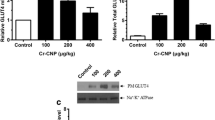Abstract
The aim of this study was to evaluate the impact of three different chromium forms—chromic chloride (CrCl3), chromium picolinate (CrPic), and a newly synthesized complex of chromium chelated with small peptides (CrSP)—on protein metabolism in vitro. In cultured skeletal muscle cells, CrSP was able to increase the basal and insulin-stimulated levels of protein deposition in skeletal muscles cells. CrCl3 and CrPic augmented insulin-stimulated protein synthesis. At the molecular level, insulin significantly increased the mRNA levels of insulin-like growth factor 1 and insulin-like growth factor 1 receptor. These impacts could be enhanced by the addition of chromium, especially CrSP. The mRNA levels of ubiquitin were significantly reduced when cells were cultured with chromium or/and insulin. Assuming that the mRNA level increase or decrease results in increased or decreased levels of these proteins, chromium would improve protein anabolism and reduce protein catabolism and then prove protein deposition in rat skeletal muscle cells.


Similar content being viewed by others
References
Vincent JB (2001) The biochemistry of chromium. J Nutr 130:715–718
Anderson RA, Bryden NA, Polansky MM, Gautschi K (1996) Dietary chromium effects on tissue chromium concentrations and chromium absorption in rats. J Trace Elem in Exper Med 9:11–17
Stearns DM, Belbruno JJ, Wetterhahn KE (1995) A prediction of chromium(III) accumulation in humans from chromium dietary supplements. FASEB J 9:1650–1657
Speetjens JK, Collins RA, Vincent JB, Woski SA (1999) The nutritional supplement chromium(III) tris(picolinate) cleaves DNA. Chem Res Toxicol 12:483–487
Qiao W, Peng Z, Wang Z, Wei J, Zhou A (2009) Chromium improves glucose uptake and metabolism through upregulating the mRNA levels of IR, GLUT4, GS, and UCP3 in skeletal muscle cells. Biol Trace Elem Res 131:133–142
Roginski EE, Mertz W (1969) Effects of chromium(III) supplementation on glucose and amino acid metabolism in rats fed a low protein diet. J Nutr 97:525–530
Evans GW, Bowman TD (1992) Chromium picolinate increased membrane fluidity and rate of insulin internalization. J Inorg Biochem 46:243–250
Davis CM, Vincent JB (1997) Chromium oligopeptide activates insulin receptor tyrosine kinase activity. Biochemistry 36:4382–4385
Livak KJ, Schmittgen TD (2001) Analysis of relative gene expression data using real-time quantitative PCR and the 2-ΔΔCT method. Methods 25:402–428
Vincent JB (2004) Recent advances in the nutritional biochemistry of trivalent chromium. P Nutr Soc 63:41–47
National Research Council (1997) The role of chromium in animal nutrition. National Academy, Washington, DC
Pollard GV, Montgomery JL, Bramble TC, Morrow JR, Richardson CR, Jackson SP, Blanton JR (2001) Effects of organic chromium on protein synthesis and glucose uptake in ruminants. Prof Anim Sci 17:261–266
Bernao A, Meseguer I, Aguilar MV, Para MC, Munoz MJ (2004) Effect of different doses of chromium picolinate on protein metabolism in infant rats. J Trace Elem Mid Bio 18:33–39
Miranda ER, CS DEY (2004) Effect of chromium and zinc on insulin signaling in skeletal muscle cells. Biol Trace Elem Res 101:19–36
Volek JS, Silvestre RR, Kirwan JP, Sharnan MJ, Judelson DA, Spiering BA, Vingren JL, Maresh CM, Vanheest JL, Kraemer WJ (2006) Effects of chromium supplementation on glycogen synthesis after high-intensity exercise. Med Sci Sports Exerc 38:2102–2109
Wang YQ, Yao MH (2009) Effects of chromium picolinate on glucose uptake in insulin-resistant 3T3-L1 adipocytes involve activation of p38 MAPK. J Nutr Biochem 20:982–991
Sun Z, Wu Y, Che S, Wang X, Guo G (2005) Effects of chromium supplementation on IRS-1 expression of skeletal muscle in diabetic rats. Wei Sheng Yan Jiu 34:88–91
Fant M, Munro H, Moses AC (1986) An autocrine/paracrine role for insulin-like growth factors in the regulation of the human placental growth. J Clin Endocr Metab 63:499–505
Harper JMM, Soar JB, Buttery PJ (1987) Changes in protein metabolism of ovine primary muscle cultures on treatment with growth hormone, insulin, insulin-like factor I or epidermal growth factor. J Endocr 112:87–96
Liu G, Wei Y, Wang Z, Wu D, Zhou A (2008) Effects of dietary supplementation with cysteamine on growth hormone receptor and insulin-like growth factor system in finishing pigs. J Agric Food Chem 56:5422–5427
Jones JI, Clemmons DR (1995) Insulin-like growth factors and their binding proteins: biological actions. Endocr Rev 16:3–34
Lecker SH, Goldberg AL, Mitch WE (2006) Protein degradation by the ubiquitin–proteasome pathway in normal and disease states. J Am Soc Nephrol 17:1807–1819
Rock KL, Gramm C, Rothstein L, Clark K, Stein R, Dick L, Hwang D, Goldberg AL (1994) Inhibitors of the proteasome block the degradation of most cell proteins and the generation of peptides presented on MHC class 1 molecules. Cell 78:761–771
Hershko A (2005) The ubiquitin system for protein degradation and some of its roles in the control of the cell division cycle. Cell Death Differ 12:1191–1197
Acknowledgments
This article was financially supported by the Program for Changjiang Scholars and Innovative Research Team in University, China, IRTO555.
Author information
Authors and Affiliations
Corresponding author
Additional information
All authors listed have contributed to the work and have agreed to submit the manuscript to Biological Trace Element Research. The manuscript is original, has not been published before, and is not under consideration for publication elsewhere.
Rights and permissions
About this article
Cite this article
Peng, Z., Qiao, W., Wang, Z. et al. Chromium Improves Protein Deposition Through Regulating the mRNA Levels of IGF-1, IGF-1R, and Ub in Rat Skeletal Muscle Cells. Biol Trace Elem Res 137, 226–234 (2010). https://doi.org/10.1007/s12011-009-8579-3
Received:
Accepted:
Published:
Issue Date:
DOI: https://doi.org/10.1007/s12011-009-8579-3




